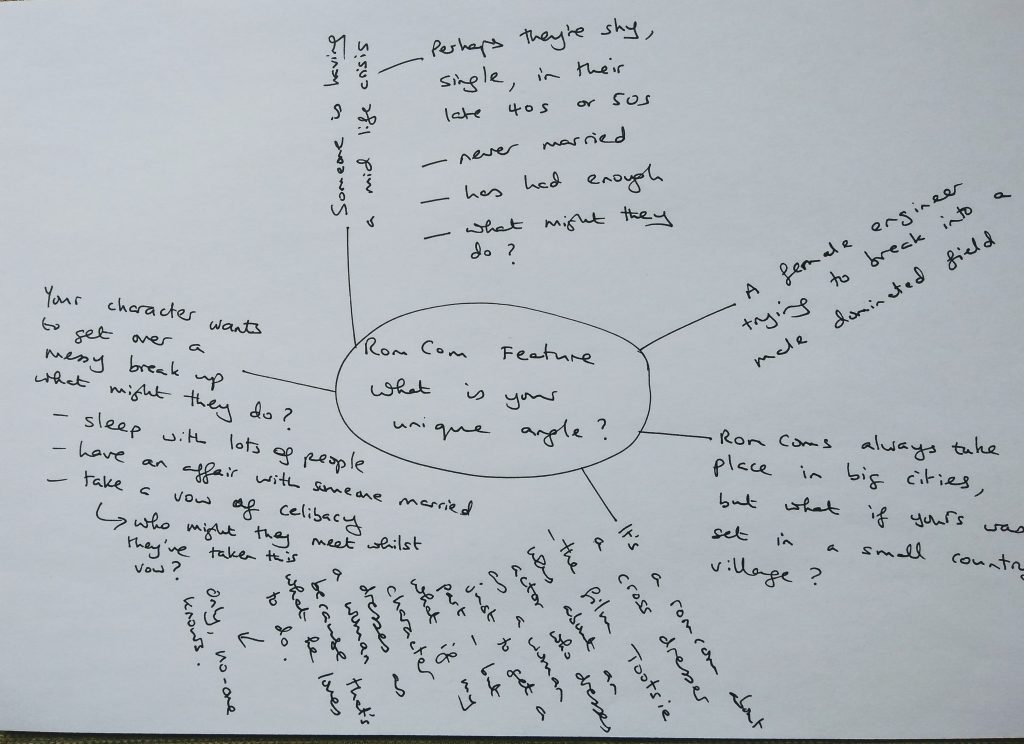Today, I want to talk about brainstorming – how it can improve your writing and when and how to do it.
When I talk about brainstorming, what I really mean is mind mapping, with pen and paper, to help you come up with new ideas
I absolutely love this technique and use it all the time. It’s so simple, you can do it on your own, whenever you face a stumbling block, or whenever you want to come up with a new idea. Your imagination becomes freer and somehow taps into both your left and your right brains at the same time. So it really is a brilliant strategy to try.
Brainstorming is a great technique to use in 3 situations
- You want to write something but don’t know what to write about
- You’re half-way through your idea and can’t figure out what should happen next
- You’re developing a series, e.g. a TV series, and you need to come up with multiple storylines and the prospect is daunting
In all these situations, brainstorming is a very effective solution. One big advantage is that it helps you come up with multiple ideas, rather than just one.
When we have lots of ideas to choose from, we can pick the best one to use. If we don’t use the brainstorming technique, the chances are we’ll plump for the first idea that crosses our mind, assume it’s brilliant and go no further. But frequently, our first ideas are obvious or clichéd, so it’s well worth digging a bit further to uncover more original and interesting ideas.
So how do you go about brainstorming?
Well, I think one of the easiest ways is to create mind maps.
Let’s say you want to write a film. There are different ways to start the process, but you could start by pin pointing the genre you want to write. Most films fit into a genre, e.g. thriller, action, horror, romantic comedy, drama, road movie, children’s animation. Pick a genre that you love and really want to write.
So when you start your mind map, in the centre of your page write the genre, for example: Romantic Comedy Feature Film
What do you need to know to help you develop your idea?
- Who it’s about
- What your unique angle is
- Where it’s set
- When it’s set
- Why you’re writing it.
I would recommend creating a separate mind map to answer as many of these questions as you feel is relevant. It doesn’t matter which one you start with – I’d simply say, start with the question where you already have an answer or two. If you start one and get stuck, don’t worry, just try another and move back and forward between them until you have plenty of ideas.
What do you write on a mind map?
There are no right or wrong answers. It’s fine to just scribble down anything that crosses your mind. No-one’s going to see this except you. Remember it’s just a tool to help you with the writing process. Give yourself permission to write a load of rubbish. Hopefully along the way you will stumble across something interesting and inspiring, and you can then brainstorm it even further.
As the saying goes, write about what you know, so if in doubt, that’s a good place to start brainstorming. So, when thinking about why you are writing this, what you have to say, what you’re an expert in, this is what your mind map might look like:

Next, moving on to your unique angle, this is what your mind map might look like:

Next, looking at who it’s about, this is what your mind map might look like:

As you can see, bits of the mind map build from the previous mind maps.
This was done quickly, it’s not meant to be a work of genius, but I hope it shows you how mind maps can take your brain in lots of different directions quite quickly and easily. They help you come up with and build on ideas, and find something that makes you feel excited to write more.
The opportunities for brainstorming are endless
Following the same principal, you can use mind mapping to expand your idea, to explore characters, to come up with sub plots, to overcome problems with your plot or to help you come up with multiple storylines for a series. Always start by writing what you’re working on in the centre of the page – in this instance, a romantic comedy. If you’re only working on an aspect of your work, write that instead – e.g. Main Character of a romantic comedy. And after that write an appropriate question to get your brain ticking over.
Are there any reasons not to use the brainstorming technique?
If you already have enough ideas and you’re avoiding committing to any of them. And this point I would not recommend doing any more brainstorming, but instead, review and evaluate your existing ideas.
Secondly, we’re not good judges of our own work and sometimes we need input from other people. In these instances, it’s worth reaching out to friends, especially writer friends, to test out our ideas, get feedback and move on to the next stage. Don’t be afraid to do that.
Get in touch!
I hope you found this helpful. I’d love to know if you give it a try now and how it goes. I personally find brainstorming one of the most fun aspects of the writing process! By the way, if any of this is unclear, do drop me a line with questions. Also, if you’d like me to explore this topic in more detail in a future post, let me know.
For more writing tips, head over here!

4 comments / Add your comment below